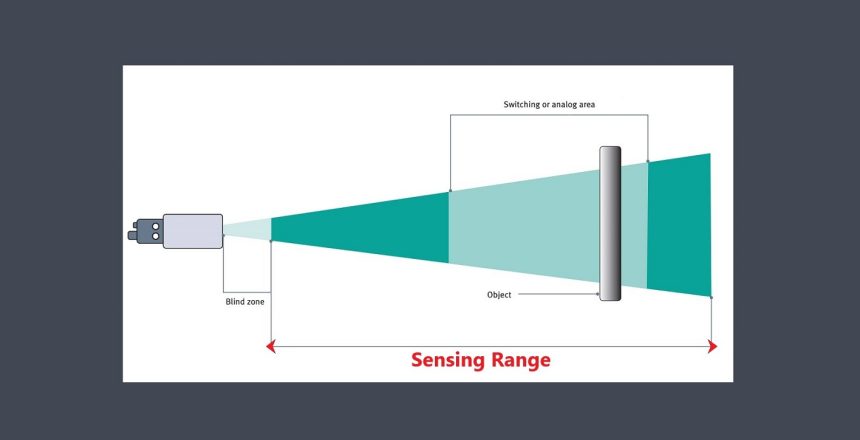
The sensing range of a sensor is a region where every event that takes place in this region can be detected by.
The sensing range of a sensor refers to the maximum distance at which the sensor can detect and measure a target or phenomenon. The sensing range can vary depending on the type of sensor and its specific design and capabilities. Here are a few examples of sensor technologies and their typical sensing ranges:
Proximity Sensors
Proximity sensors are commonly used to detect the presence or absence of an object within a certain distance. The sensing range of proximity sensors can vary from a few millimeters to several meters, depending on the technology used (such as capacitive, inductive, or optical).
Ultrasonic Sensors
Ultrasonic sensors use sound waves at frequencies higher than the human hearing range to measure distances and detect objects. The sensing range of ultrasonic sensors can extend from a few centimeters up to several meters, depending on the sensor’s power and sensitivity.
Infrared Sensors
Infrared sensors detect infrared radiation emitted or reflected by objects to determine their presence or distance. The sensing range of infrared sensors can vary from a few centimeters to several meters, depending on the sensor’s design and sensitivity.
Lidar Sensors
Lidar (Light Detection and Ranging) sensors use laser light to measure distances and create detailed 3D maps of the surrounding environment. The sensing range of lidar sensors can range from a few meters to several hundred meters, depending on the sensor’s power and the application it is designed for.
Radar Sensors
Radar (Radio Detection and Ranging) sensors use radio waves to detect and track objects in their range. The sensing range of radar sensors can vary significantly, from a few meters for short-range radar used in parking assist systems to several kilometers for long-range radar used in aviation and weather forecasting.
The sensing range of a sensor can be influenced by factors such as the target’s size, reflectivity, and environmental conditions (e.g., ambient light, temperature, and humidity). Therefore, the specified sensing range is usually an approximation or a range of values rather than an absolute measurement.
Are the sensor sensing range and sensor range the same?
The sensor sensing range and sensor range are not necessarily the same.
The sensor sensing range refers to the maximum distance at which the sensor can detect and measure a target or phenomenon accurately. It indicates the effective operating range of the sensor and is typically specified by the manufacturer.
On the other hand, the sensor range can refer to different aspects depending on the context. It can refer to the physical limits of the sensor’s capabilities, such as the maximum distance it can physically reach or the maximum value it can measure. For example, in the case of a temperature sensor, the sensor range may refer to the minimum and maximum temperature values it can measure accurately.
In some cases, the terms “sensing range” and “sensor range” may be used interchangeably, but it’s important to consider the specific context and the intended meaning of the term in order to understand whether they are referring to the same thing or if there are distinctions between them.
Relationship between sensing range and other sensor performance factors
There can be trade-offs between sensing range and other performance factors such as resolution or response time. Here are some common trade-offs to consider:
Resolution vs. Sensing Range
In some cases, increasing the sensing range of a sensor may result in reduced resolution. This means that the sensor can detect targets at a greater distance but with less precision or detail. Conversely, a sensor with higher resolution may have a limited sensing range.
Response Time vs. Sensing Range
Increasing the sensing range of a sensor may require longer response times. This is because the sensor needs to gather more data or process signals from a larger area, which can result in increased latency. On the other hand, sensors with faster response times may have a shorter sensing range due to limitations in data acquisition and processing.
Sensitivity vs. Sensing Range
Increasing the sensing range of a sensor may lead to reduced sensitivity. This means that the sensor may have a harder time detecting weaker signals or targets at a greater distance. To achieve a longer sensing range, the sensor may need to sacrifice some sensitivity.
Cost and Complexity
Increasing the sensing range of a sensor often requires more advanced technology, components, or additional features, which can increase the cost and complexity of the sensor. Therefore, there can be trade-offs between the desired sensing range and factors such as affordability and ease of use.
It’s important to carefully consider these trade-offs and prioritize the specific requirements of your application when selecting a sensor. The optimal balance between sensing range, resolution, response time, sensitivity, and other factors will depend on the specific needs and constraints of your application.

